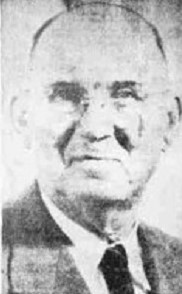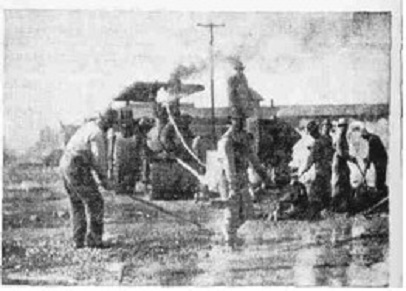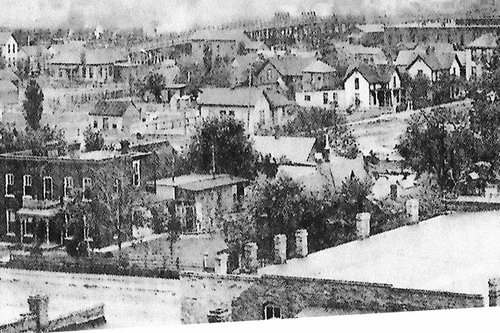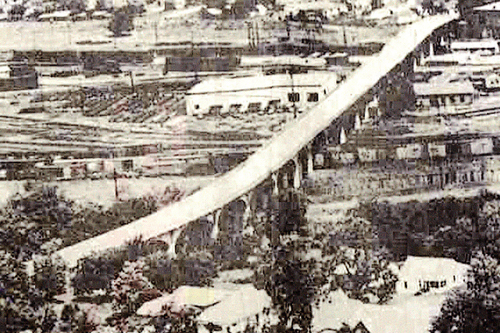 HEBER M. SCOTT  1891 - 1961 Heber
M. Scott, a resident of Denison since 1904, will end 43 years as county
engineer of Grayson and a much longer career in road construction and
maintenance in this area.
Born at Leonard Feb. 6, 1891, he came to Denison with his family 57 years ago and attended public schools and the famed Harshaw Business Academy. He topped off his schooling with a four-year correspondence course in engineering, reinforced by a lot of practical experience in that field. One of his earliest jobs was helping remodel the late Security Building from a wholesale hardware plant, for which it originally was erected, into an office structure. Starting in his late teens, Scott helped build the first, macadamized road in Texas, from Denison to Carpenter's Bluff, and figured in some of the first street paving in Denison and many miles of the first surfaced roads in this county.   Photo caption: EARLY PAVING PROJECT H. M. Scott Sr., who took this picture, was serving as city inspector when a strip of East Main street was paved in 1912. The steam roller at the rear did extra duty by furnishing steam to operate the concrete mixer in the foreground. Much of the concrete used in street paving at that time was hand-mixed on huge platforms.  1912 1912Through the summer of 1912 he worked as a chairman and later as bridge and culvert inspector for Road District No. 1, the first in Grayson County.  1916 1916Scott's first job with the county was in 1916 as assistant, to the then county engineer, Julian C. Field, who also was a Denisonian. Field and Scott are the only two men to hold the county engineer post. During his tenure as assistant county engineer, Scott helped build the first county-wide system of gravel roads, financed by a $962,000 bond issue. In all, 235 miles of roads were built, reaching into every community of any importance.  1917 1917He was on the ground floor of more Grayson road history in 1917, when he served as resident engineer for a road district, created in the Hagerman to vote all of $10,000 for 6-1/2 miles of new gravel paving.  1918 1918After a few months as resident engineer on a road construction program in Carter County, Okla.. Scott became county engineer of Grayson May 26, 1918, and has held the post since.  1927 1927A high point in his career was surveying routes for the county's first system of concrete roads, built after a 1927 bond issue. This still is the framework of the county's present highway system. CRUDE EQUIPMENT
There weren't any of the mechanical monsters that make small chores today of major road construction work. "The only power, outside of teams, we had was steam engines which pulled graders, rollers, and the big plows." Scott recalls. "All dirt was moved with slips, wheeled scrapers, elevating graders, and bottom-dump wagons all pulled by teams, preferably mules. We hitched as many teams in tandem as were needed to move the load." For some time after Scott got into the business the then common practice of using prisoners for road work continued. "The prisoners were hauled, as many as 20 at a time, to work sites in huge wagon cages, which also served as their sleeping quarters. Four or five armed guards stood watch at all times. The prisoners didn't give us much trouble as you might think, but neither did they set any records as workmen." One of the unique techniques recalled by Scott was mixing concrete, something that is done in a continuous operation today by giant machines that spew out broad concrete paths. He remembers that when Gandy street was paved about 1914 all of the concrete was mixed on room-sized platforms, much in the manner that a do-it-yourself home-owner today might mix a small batch of concrete for a step. SHOVELS KEPT BUSY "The sand, gravel, and cement were dumped in windrows," Scott explains, "and a whole army of shovel wielders would start mixing the dry ingredients, with water then added gradually. "As crude as the process was, we whipped up some concrete that workmen today are finding pretty tough when they rip it out for rebuilding jobs." Scott recalls that Frank Lee, a Negro now employed by the Goodman Co., was one of the workmen on the Gandy street project. Before he got in the groove as county engineer, Scott flitted back and forth between jobs with the city as assistant engineer, with the interurban line, and in the engineering department of the Katy, which was widening curves and otherwise beefing up its track for the inauguration of the Texas Special as a blistering-fast passenger run. 
During
one of his hitches at city hall, he helped plan the old viaduct, which
was dismantled a few years ago. But, he won't accept blame for the
design of the viaduct, which started on one street, cut diagonally
across a block, and landed on another, producing two tight corners that
proved a bane to later traffic.
 Biography Index Susan Hawkins © 2024 If you find any of Grayson County TXGenWeb links inoperable, please send me a message. |

